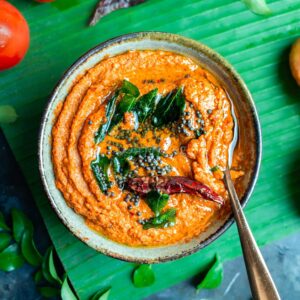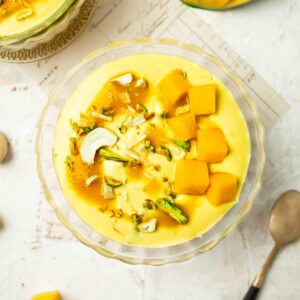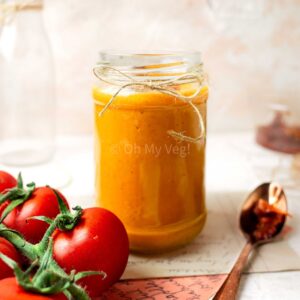Kara Chutney Recipe
With a subtle sweetness from caramelized shallots, tanginess from tomatoes, and a tongue-tingling fiery kick from dried chillies, this South Indian kara chutney is ideal for serving alongside gluten free dosa, medu vada, or fluffy idli.

While I love classic coconut chutney as much as the next person, there’s so much more to explore within South Indian cuisine — so why limit yourself? This kara chutney is the perfect option to spice up your dinner plate with something different, yet still traditional.
The recipe hails from Tamil Nadu (specifically, Chettinad) and has hallmarks of the cuisine, such as its intense heat and nutty, sizzling tempering. In fact, “kara” means “spicy” — an apt description!
Kara chutney may look unassuming, but its complex, layered flavours instantly elevate any meal. I especially love using the dip to add oomph to otherwise plain dishes, like steamed idli, but there’s no shortage of usages here.
Dollop a spoonful on the side of any thali and you’ll have everyone raving about your cooking skills. So, without further ado, let’s get into it …

🍅 What is Kara Chutney Made Of?
Wondering what ingredients you’ll need for kara chutney? There’s nothing too obscure here: some lentils, fresh vegetables and aromatics, and a few dried spices. A trip to your local Asian market should have everything you need!
I’ve split the ingredients list into two categories: things we’ll cook to make the kara chutney, and ingredients we need for the tempering, which is a flavour-packed garnish.
- Chana dal and split urad dal add a nutty flavour to the kara chutney, besides making its texture lovely and thick.
- Garlic is pungent, complementing both the shallots and tomatoes.
- Shallots are one of the main ingredients of this kara chutney. Traditionally, Indian cooks use pearl onions. However, if these are hard to find locally, substitute them for shallots or mild yellow onions.
- Dried red chillies are key to the fiery kick. Byadagi chillies — boasting a beautiful red colour, sweet flavour, and medium heat — are the prime choice in Tamil Nadu, but Kashmiri chillies are also an excellent (milder) option.
- Tomato adds a tangy flavour mellowing down into a slightly sweet taste after cooking. Use fresh tomatoes, not canned.
- Cumin seeds add warmth and earthiness.
- Sugar balances the heat. You won’t need much, and you can swap out white sugar for jaggery, which provides a caramelised, buttery, and bitter flavour that’s healthier than ordinary sugar.
Now, for the tempering — this is an aromatic, seasoned oil poured over Indian dishes like drumstick dal. Tempering helps to layer flavours, creating the intense palate Indian food is known for, massively boosting the chutney. Surprisingly, it’s very simple (yet very effective!):
- Oil is a must for the tempering — it allows the essential oils of the spices to bloom and shine. It’s a flavour carrier, so use a neutral oil.
- Mustard seeds are punchy and peppery.
- Curry leaves provide notes of fresh citrus. It’s impossible to replace them with anything else, so try your best to find fresh ones (dried ones don’t have the same flavour).
🔄 Allergies and Ingredient Substitutions
Kara chutney is an ideal side dish not simply because it boasts incredible flavours — it’s also 100% naturally vegan, gluten free, nut free, and soy free. Being free of most major allergens makes it ideal for serving a crowd.
For Indian festivals where you avoid garlic and onion, you can substitute these with a pinch of pure hing (asafoetida) during the tempering stage.
For more variations on the recipe, there’s a whole section in the text below — just scroll!

🧑🍳 How to Make Kara Chutney
Unlike coconut chutney or green chutney, kara chutney is cooked. Cooking the ingredients helps to bring out the best of their flavours, infusing the dip with layers of complex flavour.
However, making kara chutney is a simple process. It takes hardly any time! You’ll need a frying pan, 10 minutes, and a good blender — then you’re set.
- Saute the ingredients in oil, starting with the lentils and cumin seeds. Then add the shallots, garlic, dried chillies, and tomatoes. Cook on low heat until the mixture becomes soft and slightly jammy.
- Blend the mixture with sugar, salt to taste, and water to adjust the consistency.
- Make the tempering by heating oil in a tadka pan, then spluttering mustard seeds, curry leaves, and optionally, extra red chillies.
- Pour the tempering over the chutney and serve.
🌶️ Variations
Once you’ve made this Tamil-style kara chutney recipe a few times, you’ll know what can be adapted and what’s essential to its core flavours.
Once you’re ready to experiment, I’ve got a few fun suggestions for you:
- Adjust the spice levels using different varieties of dried red chillies, or adding extra! You can even vary the flavour profile subtly by adding fresh green chillies for a sharper, punchier kick. To tone it down, add some fresh coconut (not traditional, but scrumptious!)
- Add warmth to the kara chutney by including a small amount of ginger when sauteeing.
- Skip the onions and garlic for festive fasting (vrat) days.
- Use different ingredients in the tempering such as extra split urad dal, asafoetida (hing), and even sesame seeds.
- If you want to store the spicy kara chutney for longer periods, after blending the chutney saute it further until the oil seperates and it becomes very thick.
- Adjust the consistency with water to get your preferred thickness! I like mine rustic and thick. Prefer yours completely smooth and thinner? No problem! Add more water while blending and pass it through a sieve before topping with tempering.

🍛 How to Serve Kara Chutney
Because kara chutney is cooked, it tastes fantastic hot! However, serving it cold is just as delicious — if anything, the flavours are more punchy.
I love to serve kara chutney with a proper South Indian breakfast feast of idli, dosa, and medu vada. However, uttapam, paniyaram, and even chapati taste just as great with this flavour-packed recipe. These pairings let all that explosion of spice shine!
Traditionally, you would dollop kara chutney straight onto a clean banana leaf and eat it with your right hand.
Kara chutney can be stored for up to a week if kept in an airtight container, making it the perfect side dish to meal prep.
❤️🔥 This Recipe Is …

Kara Chutney Recipe
Ingredients
For the Chutney
- 2 teaspoons oil neutral
- 1 tablespoon chana dal
- 1 tablespoon split urad dal
- ½ teaspoon cumin seeds
- 3 cloves garlic
- 120 g shallots*
- 6 dried red chillies
- 2 medium tomatoes
- ½ teaspoon sugar
- 2 tablespoons water
For the Tempering
- 2 teaspoons oil neutral
- ½ teaspoon mustard seeds black
- 1 sprig curry leaves
- dried red chillies optional
Instructions
- In a small saucepan or frying pan, heat 2 teaspoons oil over medium heat. Once hot, add 1 tablespoon chana dal and 1 tablespoon split urad dal, then cook until golden. Next, add ½ teaspoon cumin seeds, 120 g shallots*, and 3 cloves garlic. Saute for a minute or so, or until lightly softened. Then add 6 dried red chillies, 2 medium tomatoes, ½ teaspoon sugar, and salt to taste. Cook, stirring occasionally, until soft and slightly jammy.
- Add the chutney to a high-speed mixer-grinder and blend with 2 tablespoons water until you achieve a smooth, thick paste.
- Heat 2 teaspoons oil in a small tadka pan. Once hot, add ½ teaspoon mustard seeds until they pop. Immediately add 1 sprig curry leaves and optionally, extra dried red chillies.
- Pour the tempering over the chutney and serve.
Notes
** Add more water (1 tbsp at a time) for a thinner chutney.












